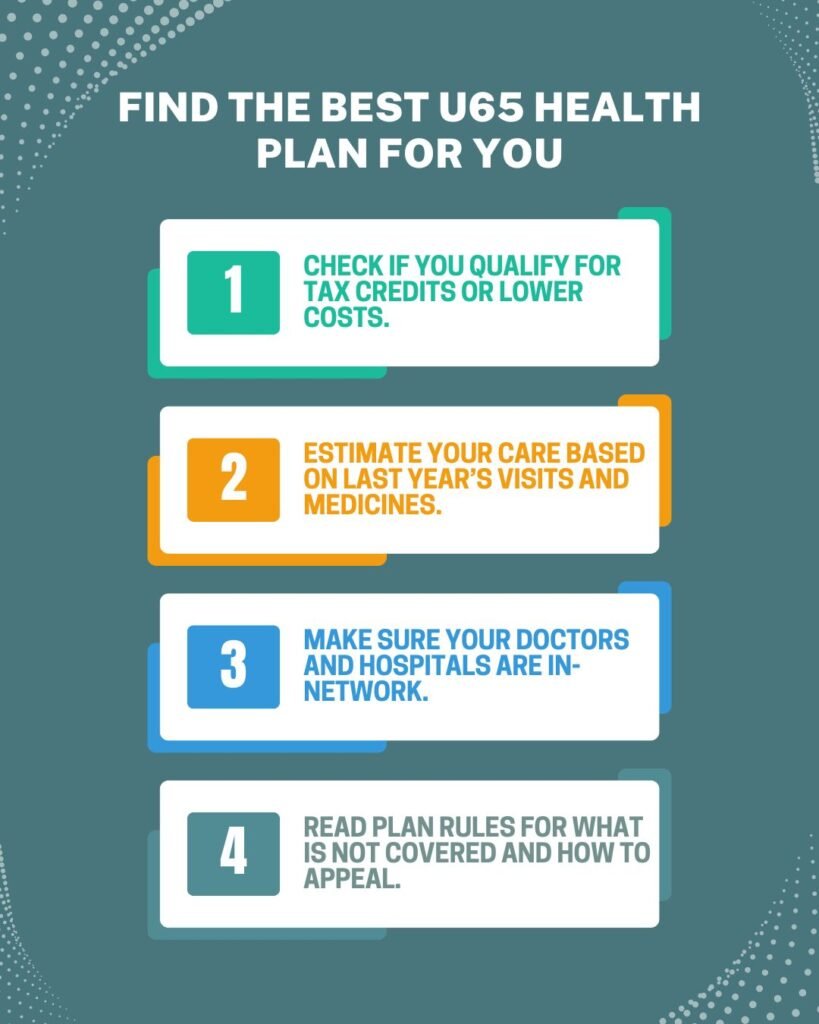
Choosing a U65 health plan can be confusing. Your health needs can change every year. Maybe you left a job, started freelancing, or need coverage before Medicare. Costs like premiums, deductibles, and co-pays matter. Networks and benefits matter too. This guide will help you understand the basics. You will learn how to pick a u65 health plan that fits your budget and keeps you healthy.
Imagine a parent between jobs choosing a u65 health plan, or a recent graduate looking at short-term coverage versus a regular health policy. Some may need to decide between keeping COBRA or starting a new personal plan. No matter the case, picking a u65 health plan should be simple. This guide helps you see your options, compare costs and benefits, and choose a plan that works for your life.

A u65 health plan is a health policy for adults under 65 who cannot get Medicare. It is for people changing jobs, self-employed workers, early retirees, students leaving a parent’s plan, and families between employer coverage. You can buy a u65 health plan on state or federal Marketplaces under the ACA, or directly from insurers. Where you live, your age, and your legal status decide if you can apply. Your income helps decide if you get tax credits or lower costs.
A u65 health plan can start during Open Enrollment or after life changes. Life changes include losing a job, moving, or having a baby. These plans cover important care, like doctor visits, medicine, mental health, hospital care, and care for children. A u65 health plan must cover health problems you already have. Plans with higher costs usually mean you pay less when you need care.
A u65 health plan has different networks. Some are HMOs, PPOs, or EPOs. HMOs need you to see a main doctor first and get referrals. PPOs and EPOs let you see specialists more easily, but rules for outside doctors may differ. Knowing your plan type helps you see where to get care and what it costs. Your family size and income can also lower your plan cost.
Medicare applies to individuals 65 and above or even those with disabilities. Adults below 65 who are unable to access Medicare require a u65 health plan. Part A covers the hospital care and Part B covers the doctor care, Part D covers the medicine and optional Medicare Advantage plans are combinations of Part A, Part B, Part D and Part Medicine.
The individuals or families are covered in a u65 health plan. The plan contains regulations concerning physicians, expenses, and networks. Expenses are in terms of premiums, deductibles and other charges. The worker pays part of the employer insurance and group plans might not allow using tax credits.
The COBRA allows others to continue with their employment-related insurance even when they stop working, but this is costly. Individuals who are not covered by their employers seek out u65 health plans in order to acquire good prices, physicians and benefits.
The time of enrolment varies as well. Open Enrollment or special life events are the rules of the u65 health plans, although Medicare has its own. Do not forget to make sure your medicine and doctors are covered in the plan.
Covers ten important health services. These include check-ups, emergency care, care for moms and babies, medicine, and mental health help. Preventive care with an A or B rating from the U.S. Preventive Services Task Force is free when you use in-network doctors.
A U65 health plan comes in metal levels: Bronze, Silver, Gold, and Platinum. These levels show how much you pay for premiums and care. Silver plans can give extra help to some families, lowering deductibles and copays so regular care costs less.
Some people choose a u65 health plan with a high-deductible and a health savings account (HSA). You can put in money before taxes and use it for medical costs without extra tax. Others like plans with set copays for visits or bigger networks to see specialists. Medicine is grouped in tiers, and each tier decides your cost at the pharmacy. Ordering by mail can save money, but check delivery times and refill rules.
When choosing a U65 health plan, compare these features:
Network rules are important, especially if you need a clinic outside the plan. The Summary of Benefits shows costs for standard care. Always read plan documents for what is not covered, approval steps, and appeal rules.

To choose the right u65 health plan, look at the total cost of care, not just the monthly price. Add your deductible, copays, and medicine costs. Make a list of your doctors, hospitals, and clinics, then check if they are in the plan’s network. Look at the medicine list to see what is covered and if you need approval before getting it.
If you need more care, a plan with a higher premium but lower costs when you visit doctors may save you money. Use a simple checklist to compare plans by price, doctors, and benefits.
Learn about Marketplace open times to sign up or change your plan. If you had a big life event, like moving, having a baby, or losing coverage, you may get a Special Enrollment Period. Gather papers early to avoid delays.
Compare HMO, PPO, and EPO plans. Each has different costs, rules, and networks. Ask your doctor which plans they take. Add your premium and out-of-pocket limit to see your worst-case cost for the year. Write down all plan details in a simple chart to find the best value.
Health insurance can feel hard to understand. Deadlines, income limits, and doctor networks can be confusing. But with clear help, you can find a u65 health plan that fits your health and budget. OLPolicy helps you choose the right plan by checking your needs, doctors, and medicine costs. You can see the full cost of care and make smart choices with confidence.
Talk to a caring expert at (866) 757-5350 to review your options, check savings, and confirm your doctors and prescriptions. You can also visit OLPolicy online to get simple, step-by-step help from licensed professionals.